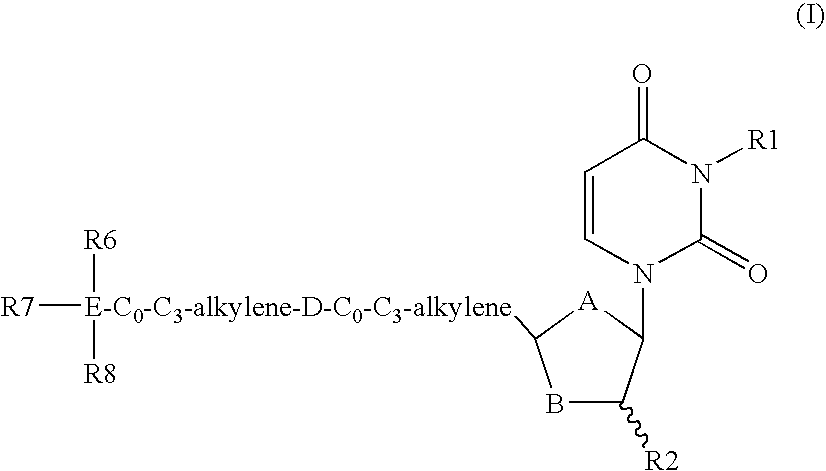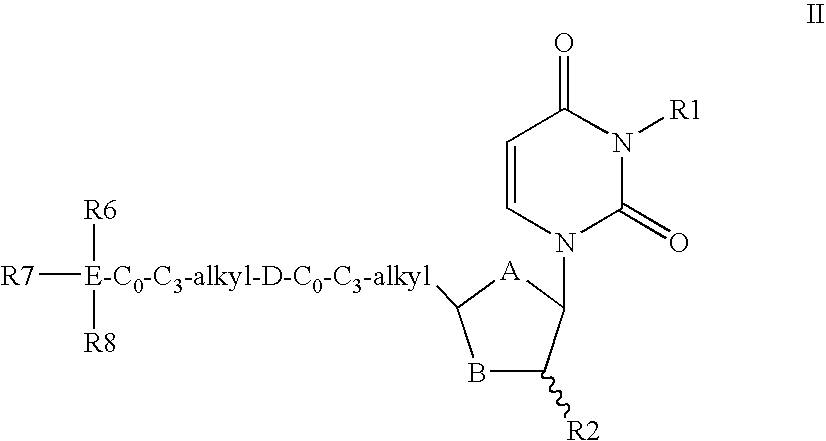Dutpase Inhibitors
a technology of dutpase and inhibitors, applied in the field of pharmaceuticals, can solve the problems of increasing the misincorporation of uridine into dna
- Summary
- Abstract
- Description
- Claims
- Application Information
AI Technical Summary
Benefits of technology
Problems solved by technology
Method used
Image
Examples
example 1
[0092]
1-(5-Trityloxymethyl-2,5-dihydrofuran-2-yl)-1H-pyrimidine-2,4-dione or 5′ trityl-2′,3′-dideoxydidehydrouridine (1)
[0093]2′,3′-Dideoxy-didehydrouridine (0.30 g, 1.43 mmol) and triphenylmethyl chloride (0.44 g, 1.57 mmol) was stirred in dry pyridine (10 ml) at 50° C. overnight under an atmosphere of nitrogen. The reaction mixture was poured into ice-H2O (30 ml) with vigorous stirring and filtered. The precipitate was dissolved in EtOAc (50 ml) and the solution was washed with 0.5M HCl (20 ml), H2O (20 ml), dried (Na2SO4) and reduced in vacuo to yield a crude product, which was purified by gradient flash column chromatography eluting with 0→3% MeOH / CHCl3 to yield the title compound as white crystals (0.37 g, 58%).
[0094]1H NMR (300 MHz; MeOH): δ 3.56 (2H, m, 5′-H), 5.02 (1H, m, 4′-H), 5.08 (1H, m, 5-H), 5.93 (1H, m, 1′-H), 6.40 (1H, m, 2′-H), 7.09 (1H, m, 3′-H), 7.30-7.44 (15H, m, Ph-H), 7.87 (1H, d, J=8.1 Hz, 6-H);
[0095]13C NMR (75 MHz; MeOH): δ 64.82 (5′-CH2), 86.38 (1′-CH), 87....
example 2
[0098]
[0099]5′-O-tert-butyldiphenylsilyl-2′,3′-dideoxydidehydrouridine (2)
[0100]2′3′-dideoxy-didehydrouridine (0.30 g, 1.43 mmol) in dry DMF (10 ml) were added drop-wise under an atmosphere of nitrogen, with ice bath cooling, to a stirred solution of tert-butyldiphenylsilylchloride (0.41 ml, 1.57 mmol) and imidazole (0.21 g, 3.14 mmol) in dry DMF (10 ml). The mixture was allowed to warm to room temperature and stirred overnight. H2O (10 ml) was added and the mixture was extracted with CHCl3 (2×30 ml). The combined extracts were washed with saturated aqueous NaHCO3 solution (10 ml) and H2O (10 ml), dried (Na2SO4) and reduced in vacuo to obtain a crude product, which was purified by gradient flash column chromatography eluting with 0→3% MeOH / CHCl3 to yield the title compound as colourless viscous oil (0.46 g, 73%).
[0101]1H NMR (300 MHz; MeOH): δ 1.15 [9H, s, C(CH3)3], 3.95 (1H, dd, J=2.9, 11.7 Hz, 5′-H), 4.06 (1H, dd, J=2.9, 11.7 Hz, 5′-H), 4.97 (1H, m, 4′-H), 5.26 (1H, d, J=8.1 Hz, 6...
example 3
[0107]
Diphenyl(pyridin-3-yl)methanol (3)
[0108]A solution of 3-bromopyridine (10 g, 0.063 mol) in dry THF (200 mL) / hexane (50 mL) was cooled to −90° C. To this cooled solution was added n-BuLi (2.2 M, 32 mL, 0.063 mol) slowly and allowed to stir for 30 min under N2 atmosphere. A solution of benzophenone (11.5 g, 0.063 mol) in dry THF (50 mL) was added to this at the same temperature over a period of 30 min. The reaction mixture was warmed slowly to RT and allowed to stir another 3 h at RT. The reaction mixture was cooled, quenched with water (200 mL) and extracted with ethylacetate (2×100 mL). The organic layer was dried, concentrated under vacuum and crude purified by column chromatography over silica gel (30% ethyl acetate in petroleum ether) to give the title product (3.3 g).
PUM
| Property | Measurement | Unit |
|---|---|---|
| temperature | aaaaa | aaaaa |
| temperature | aaaaa | aaaaa |
| temperature | aaaaa | aaaaa |
Abstract
Description
Claims
Application Information
 Login to View More
Login to View More - R&D
- Intellectual Property
- Life Sciences
- Materials
- Tech Scout
- Unparalleled Data Quality
- Higher Quality Content
- 60% Fewer Hallucinations
Browse by: Latest US Patents, China's latest patents, Technical Efficacy Thesaurus, Application Domain, Technology Topic, Popular Technical Reports.
© 2025 PatSnap. All rights reserved.Legal|Privacy policy|Modern Slavery Act Transparency Statement|Sitemap|About US| Contact US: help@patsnap.com



